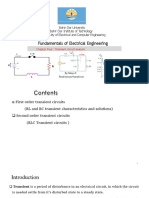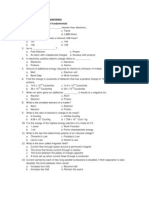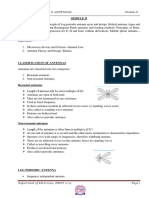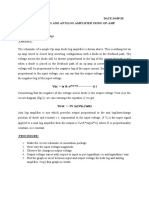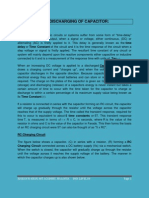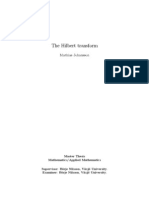1.RC Circuits
1.RC Circuits
Uploaded by
Naveen ChCopyright:
Available Formats
1.RC Circuits
1.RC Circuits
Uploaded by
Naveen ChOriginal Description:
Copyright
Available Formats
Share this document
Did you find this document useful?
Is this content inappropriate?
Copyright:
Available Formats
1.RC Circuits
1.RC Circuits
Uploaded by
Naveen ChCopyright:
Available Formats
RC CIRCUITS Objectives:You will be able to Draw voltage & Current graphs for a capacitor being changed via a resistor
or from a dc voltage source & explain the shape of the graphs. Write the equation for instantaneous capacitor voltage in a series RC Circuit with a DC voltage source. Calculate the capacitor and resistor voltages at any time from the instant of supply switch-on when the capacitor is initially uncharged and when it is already partially charged. Define the time constant for a series RC Circuit and derive equations relating various levels of capacitor voltage, charging time, and time constant. Perform calculations involving the circuit time constant. Show how the input circuit of an amplifier can be represented as an RC Circuit. Perform calculations involving R, C, the circuit upper cutoff frequency the rise time at the output, the circuit lower cutoff frequency and the tilt on the top of a rectangular output waveform. Sketch differentiating & integrating circuits explain their operation and determine the expected output voltages for given inputs. Introduction:When a capacitor is charged from a dc voltage source through a resistor the Instantaneous level of capacitor voltage may be calculated at any given time. There is a definite relationship between the time constant of an RC circuit and the times required for the capacitor to charge to approximately 63% and 99% of the input voltage. Also, an important relationship exists between the time constant of a circuit and the rise time of the output voltage from the circuit. Depending upon the arrangement of the RC circuit, it may be employed as an integrator or a differentiator.
DEPT. OF ECE,NITW PULSE CIRCUITS LAB
1.1
Experiment No.1 RC CIRCUITS Aim:- To design an integrator and a differentiator and observe the output for Square wave inputs. Components and Equipments:-Resistors, Capacitors, function generator, CRO, Groove board, BNC, Patch cards, clips. 1) Circuit diagram:C Vi R + Vo Fig1.1: High pass RC Circuit Design:- Let the lower 3db frequency (fc) = 5kHz fc = 1/2 RC Assume C= 10nF then R = 3.183K Procedure1:Differentiating circuit: Construct an RC differentiating circuit as in figure1.1 using R = 2.2K and C = 0.1f. Apply a 10V, 500Hz square wave input and monitor both input & output waveform on a (dc- coupled) Oscilloscope. Sketch the input and output waveform for f = 500Hz carefully noting the amplitude and the phase relationship between input & output. Change the signal frequency to 50 Hz, 5KHz & 50KHz in turn. Sketch the input & Output waveforms in each case. Change the input to triangular waveform and again repeat the above procedures .
DEPT. OF ECE,NITW
PULSE CIRCUITS LAB
1.2
Square wave input:T1 Vi V' V V'' Vdc t T2
Vo When >>T A1 A2 T T1 Input wave Vi T2 V t O/p wave (peaking of The square wave result from a time constant small Compared with T) -V T The square wave response of a high pass RC circuit. The dashed curve would represent the o/p if RC>>T The percentage tilt P is defined by P = (V1-V1)/V/2 x 100 T/ 2RC x 100% fc/f x 100%
DEPT. OF ECE,NITW PULSE CIRCUITS LAB
V t
1.3
Where f = 1/T is the frequency of the applied input square wave V1 V1' V T/2 V2 Observations:i/p voltage: ________(p-p) Frequency (Hz) o/p (V) gain (db) Phase (deg) T/2 V2' t
Expected wave form:Gain (db) 3db
fc Results:Lower 3db frequency (fc) =________KHz Phase shift at cut off freq =________ Time constant of the circuit =_____ sec Percentage of Tilt (P) =______
DEPT. OF ECE,NITW
freq
PULSE CIRCUITS LAB
1.4
Conclusion:- 1) It acts as a differentiator, when <<T 2) The dc component of the o/p is always is zero. 2) Circuit diagram:R V i
+
C
Vo Fig1.2: Low Pass RC Cicrcuit Design:- Let the upper 3db frequency (fc) = 5KHz Fc = 1/2 RC Assume C = 10nF then R = 3.183K Procedure2:Integrating circuit: 2-1.Rearrange R & C as an integrating circuit as illustrated in fig 1.2. 2-2. Repeat procedures 1-2 through 1-5 for the integrating circuit. Square wave I/P:V' T V Vdc V'' t
DEPT. OF ECE,NITW
PULSE CIRCUITS LAB
1.5
O/P waveform:(i) RC<<T 0.9V 0.1V t tr (ii) RC = T V2 V1 t
(iii) RC >> T V3
V4
t Observations:I/P voltage =_______(p-p) Frequency (Hz) Output (V) Gain (db) Phase (deg)
DEPT. OF ECE,NITW
PULSE CIRCUITS LAB
1.6
Typical frequency response: Gain (db) 3db fc Results:Upper 3db frequency (fc) =_____kHz Phase shift at cutoff freq =______o Time constant of the circuit =_____sec Rise time (tr) =______ns. Analysis: Discuss each output waveform in comparison to the input & explain the shape of the outputs in terms of the circuit time constant. Calculate the expected output amplitude with the 500Hz triangular wave input to the differentiating circuit. Compare to the measured output amplitude. Calculate the expected output amplitude when the 50KHz square wave input is applied to the integrating circuit. Compare to the measured output amplitude. Conclusion:The low pass RC circuit acts as an integrator when RC >>T. freq
DEPT. OF ECE,NITW
PULSE CIRCUITS LAB
1.7
You might also like
- Electronic 1 Lab 4 PDocument10 pagesElectronic 1 Lab 4 PAtyia JavedNo ratings yet
- IObit Driver Booster Pro 660 Serial Key + Crack (Updated)Document5 pagesIObit Driver Booster Pro 660 Serial Key + Crack (Updated)josep700% (1)
- SAP Transaction CodesDocument1 pageSAP Transaction CodesHemant RasamNo ratings yet
- Rockit Pro DJ Manual v4Document52 pagesRockit Pro DJ Manual v4Almi ZarindiNo ratings yet
- How To Hack Wifi Wpa and Wpa2 Without Using Wordlist in Kali Linux or Hacking Wifi Through Reaver - Hacking-News & TutorialsDocument15 pagesHow To Hack Wifi Wpa and Wpa2 Without Using Wordlist in Kali Linux or Hacking Wifi Through Reaver - Hacking-News & TutorialsTom CattNo ratings yet
- EC - Lab Manul With Viva Questions and AnswersDocument83 pagesEC - Lab Manul With Viva Questions and AnswerssunandaalurNo ratings yet
- RC Time ConstantDocument2 pagesRC Time ConstantJunaid AhmadNo ratings yet
- Chapter-4 Transient Circut Analysis Part 1Document16 pagesChapter-4 Transient Circut Analysis Part 1temesgen adugnaNo ratings yet
- Circuit Theory: First-Order CircuitsDocument22 pagesCircuit Theory: First-Order Circuitsmalek992No ratings yet
- Time Constant of RC CircuitDocument13 pagesTime Constant of RC CircuitADRMNo ratings yet
- NEC3203 Geminiano Assignment-6Document13 pagesNEC3203 Geminiano Assignment-6JOSEFCARLMIKHAIL GEMINIANONo ratings yet
- Instrumentation AptitudeDocument77 pagesInstrumentation AptitudePrasath KumarNo ratings yet
- A.3 Additional Instrument Theory: A.3.1 Basic DC MetersDocument10 pagesA.3 Additional Instrument Theory: A.3.1 Basic DC MetersadnaniaziNo ratings yet
- EDC Lab ManualDocument45 pagesEDC Lab ManualChirag Sachdeva100% (2)
- Andersons BridgeDocument3 pagesAndersons BridgeRamesh KumarNo ratings yet
- Experiment # 4: Designing Ammeter Using Weston Type GalvanometerDocument6 pagesExperiment # 4: Designing Ammeter Using Weston Type GalvanometerAbdullah TahirNo ratings yet
- Chapter SixDocument5 pagesChapter Sixyunus memonNo ratings yet
- Sample and Hold AssignmentDocument8 pagesSample and Hold AssignmentRen BurnettNo ratings yet
- Operational Amplifier 741 As Wein Bridge Oscillator 1Document4 pagesOperational Amplifier 741 As Wein Bridge Oscillator 1Deepak SharmaNo ratings yet
- RL TransientDocument35 pagesRL Transientkrish104411No ratings yet
- AC Circuits: Fundamentals of Electric CircuitsDocument16 pagesAC Circuits: Fundamentals of Electric CircuitsHiếu Dương100% (1)
- Lecture Slides-Network AnalysisDocument35 pagesLecture Slides-Network Analysisaසිල්වාNo ratings yet
- Lab 06 RC, RL, and RLC Transients-2Document11 pagesLab 06 RC, RL, and RLC Transients-2Ece KayaNo ratings yet
- EE 370 Electronic Instrument Assignment 3Document1 pageEE 370 Electronic Instrument Assignment 3vineet mishra100% (1)
- Lab 1 Experiment 1 & 2Document18 pagesLab 1 Experiment 1 & 2Harry Hoon100% (1)
- Experiment No. - 5 EXPERIMENT NAME: To Determine Accurate Quality Factor of An Unknown Coil. TheoryDocument5 pagesExperiment No. - 5 EXPERIMENT NAME: To Determine Accurate Quality Factor of An Unknown Coil. TheoryDibyajit SenNo ratings yet
- ET Lab ManualDocument52 pagesET Lab Manualcholleti sriram100% (1)
- Darlington PairDocument3 pagesDarlington Pairlakka srinivas100% (1)
- Voltmeter Connected. SensitivityDocument30 pagesVoltmeter Connected. SensitivityzsssxNo ratings yet
- Tribhuwan University: Lab No:..... Sinusoidal OscillatorsDocument5 pagesTribhuwan University: Lab No:..... Sinusoidal OscillatorsKRSTNo ratings yet
- Solved Problems To Chapter 09Document4 pagesSolved Problems To Chapter 09REjosh BonifacioNo ratings yet
- To Analyze The Sinusoidal Response of RLC CircuitDocument4 pagesTo Analyze The Sinusoidal Response of RLC CircuitMalik Abdul MajeedNo ratings yet
- Linear Wave Shaping-Integrator and DifferentiatorDocument5 pagesLinear Wave Shaping-Integrator and DifferentiatorManjot Kaur0% (1)
- Ece ReviewDocument77 pagesEce ReviewLeonard Jobet Villaflor PantonNo ratings yet
- Objective: Setup Example 1Document9 pagesObjective: Setup Example 1emailkprajeshNo ratings yet
- Constant Current BiasDocument36 pagesConstant Current BiasKRISHNAVINOD100% (7)
- EXP2 Half Wave RectifierDocument3 pagesEXP2 Half Wave RectifierMohammed Dyhia Ali50% (2)
- 07NANO107 Transient Analysis of RC-RL CircuitsDocument20 pages07NANO107 Transient Analysis of RC-RL CircuitsJames Hyun Wook ParkNo ratings yet
- Aim: To Test Differentiator and Integrator Circuits Using Ua741op-AmpDocument8 pagesAim: To Test Differentiator and Integrator Circuits Using Ua741op-AmpAvinash Nandakumar100% (1)
- Objective: Design A Practical Integrator Circuit Using Common OP AMP Circuits. TestDocument10 pagesObjective: Design A Practical Integrator Circuit Using Common OP AMP Circuits. TestVinoth KumarNo ratings yet
- Chapter3 NodalDocument45 pagesChapter3 Nodalpsychic_jason0071319No ratings yet
- Ect401 M2Document15 pagesEct401 M2hrithikNo ratings yet
- Experiment No. 4 Common Emitter Amplifier AIM: Fig 1. Circuit DiagramDocument4 pagesExperiment No. 4 Common Emitter Amplifier AIM: Fig 1. Circuit Diagrampandiyarajan142611No ratings yet
- Experiment 05: Experiment Title: Study of A 741 Operational Amplifier As Active High Pass and Low Pass FiltersDocument11 pagesExperiment 05: Experiment Title: Study of A 741 Operational Amplifier As Active High Pass and Low Pass FiltersAaa Aaa100% (1)
- Diode Clippers: 1. Positive Clipper and Negative ClipperDocument6 pagesDiode Clippers: 1. Positive Clipper and Negative ClipperBibek ThapaNo ratings yet
- Analog ElectronicsDocument361 pagesAnalog ElectronicsVia Marie MesaNo ratings yet
- Basic ElectronicsDocument9 pagesBasic ElectronicsNeil OheneNo ratings yet
- 08-Com101 AMDocument11 pages08-Com101 AMHồng HoanNo ratings yet
- Thevenin's and Norton's TheoremDocument3 pagesThevenin's and Norton's TheoremDozdi80% (5)
- EECE210 Spring2021 Chap+4Document55 pagesEECE210 Spring2021 Chap+4starboyNo ratings yet
- Experiment No:-07 DATE:24-09-20 Aim: To Realize Log and Antilog Amplifier Using Op-AmpDocument9 pagesExperiment No:-07 DATE:24-09-20 Aim: To Realize Log and Antilog Amplifier Using Op-AmpJainil ShahNo ratings yet
- Time Domain AnalysisDocument94 pagesTime Domain AnalysisAbhayNo ratings yet
- Measurement of Resistance, Inductance and CapacitanceDocument64 pagesMeasurement of Resistance, Inductance and CapacitanceSiddhesh ShirshivkarNo ratings yet
- Lab Manual DAC-SignedDocument10 pagesLab Manual DAC-Signedabidrk_21789100% (2)
- Diode Clamping CircuitsDocument4 pagesDiode Clamping CircuitsftafedeNo ratings yet
- Lab 9Document5 pagesLab 9gratz_redobleNo ratings yet
- Eca Lab ManualDocument78 pagesEca Lab ManualNageswariah.MNo ratings yet
- "Single Phase Full Wave Rectifier": Power Point Presentation OnDocument12 pages"Single Phase Full Wave Rectifier": Power Point Presentation Onshadan alamNo ratings yet
- The Integrator AmplifierDocument6 pagesThe Integrator AmplifierJohn Brix BalisterosNo ratings yet
- Time Constant RCDocument9 pagesTime Constant RCHassan M Khan0% (1)
- Activity No. 6 Series Resistance Inductance Circuit ObjectivesDocument4 pagesActivity No. 6 Series Resistance Inductance Circuit ObjectivesJohn Paul BaquiranNo ratings yet
- Electromagnetism: Angelito A. Silverio, EceDocument71 pagesElectromagnetism: Angelito A. Silverio, EceRaphael Patrick GileraNo ratings yet
- 1 RC CircuitsDocument7 pages1 RC CircuitsMohmed Al NajarNo ratings yet
- Wein Bridge OscillatorDocument6 pagesWein Bridge Oscillatorinspectornaresh100% (1)
- zrWQ4Bk XHMC (1711986)Document144 pageszrWQ4Bk XHMC (1711986)Naveen ChNo ratings yet
- Ram Ahuja - Social Problems in India PDFDocument399 pagesRam Ahuja - Social Problems in India PDFPrakram Prasad100% (1)
- EXAM, 2010: Cs (Main)Document32 pagesEXAM, 2010: Cs (Main)Naveen ChNo ratings yet
- F-Dtn-M-Nuia Mathematics: Paper-1Document32 pagesF-Dtn-M-Nuia Mathematics: Paper-1Naveen ChNo ratings yet
- Incorporating Pre-Emphasis: Consumer Electronics, FebruaryDocument10 pagesIncorporating Pre-Emphasis: Consumer Electronics, FebruaryNaveen ChNo ratings yet
- Hilbert TransformDocument36 pagesHilbert Transforman_danuNo ratings yet
- Qex 1Document9 pagesQex 1Aamir HabibNo ratings yet
- HEN-PFG690 SPM PDFDocument106 pagesHEN-PFG690 SPM PDFAndres Jose Amato TorresNo ratings yet
- Metod Statement of Well Point De-Watering For Cement SiloDocument5 pagesMetod Statement of Well Point De-Watering For Cement SiloSmart ShivaNo ratings yet
- CCNP Routing&Switching ProgramDocument2 pagesCCNP Routing&Switching ProgramClaudian PaduraruNo ratings yet
- Complaint Process Flow ChartDocument1 pageComplaint Process Flow ChartBharath100% (1)
- Anguler 1Document20 pagesAnguler 1Chathuranga WeerakoonNo ratings yet
- MP Assignment - Sentosa Development CorporationDocument12 pagesMP Assignment - Sentosa Development CorporationEvelynyumikoNo ratings yet
- Sketchbooks - Writing A Scene AnalysisDocument2 pagesSketchbooks - Writing A Scene Analysismarcatkinson100% (1)
- CATT Jan 2010 Trenchless OverviewDocument24 pagesCATT Jan 2010 Trenchless OverviewChen YishengNo ratings yet
- Plant Visit Written ReportDocument30 pagesPlant Visit Written Reportapi-285267466No ratings yet
- Neopor F 5300 PlusDocument3 pagesNeopor F 5300 PlusАлександр МихайловичNo ratings yet
- Styrene Conf Louisville ADocument7 pagesStyrene Conf Louisville ANguyễn Văn LựcNo ratings yet
- Significance of Hash Value Generation in Digital Forensic: A Case StudyDocument7 pagesSignificance of Hash Value Generation in Digital Forensic: A Case StudyIJERDNo ratings yet
- Trg-b1003 Piping Study Column PipingDocument53 pagesTrg-b1003 Piping Study Column Pipingfronjose100% (3)
- Hadoop Admin Training 2Document42 pagesHadoop Admin Training 2babul1985No ratings yet
- How The Royal Enfield Bullet 4-Speed Gearbox Works: Mauro July 6, 2009Document5 pagesHow The Royal Enfield Bullet 4-Speed Gearbox Works: Mauro July 6, 2009antonymariaNo ratings yet
- Investigation of Voltage Quality in Electric Arc Furnace With Matlab/SimulinkDocument11 pagesInvestigation of Voltage Quality in Electric Arc Furnace With Matlab/SimulinkerpublicationNo ratings yet
- Downloads IndyKBDocument47 pagesDownloads IndyKBIrwan GatotNo ratings yet
- McAfee File and Removable Media Protection (FRP) 4.3.0 - User Guide - EN PDFDocument27 pagesMcAfee File and Removable Media Protection (FRP) 4.3.0 - User Guide - EN PDFHammerzorNo ratings yet
- LNG Regasification SafetyDocument54 pagesLNG Regasification SafetyIgnatius Samraj100% (3)
- Exercise: Arrays, Clusters, and Text-Based Nodes: File New VIDocument3 pagesExercise: Arrays, Clusters, and Text-Based Nodes: File New VIPedro Santana RomanNo ratings yet
- MCA ResumeDocument2 pagesMCA Resumesulemankhan18No ratings yet
- Troubleshooting Guide PDFDocument122 pagesTroubleshooting Guide PDFrampriya27No ratings yet
- 18a Mcr225a PDFDocument22 pages18a Mcr225a PDFVengatesh HariNo ratings yet
- Algorithm and Programming Language MCQ'SDocument25 pagesAlgorithm and Programming Language MCQ'SGuruKPO100% (3)
- Nano IP Series - IPn920.Brochure - Rev.1.04Document2 pagesNano IP Series - IPn920.Brochure - Rev.1.04Ronald Romani FloresNo ratings yet
- Chapter1 (Classification)Document16 pagesChapter1 (Classification)110me0313No ratings yet







